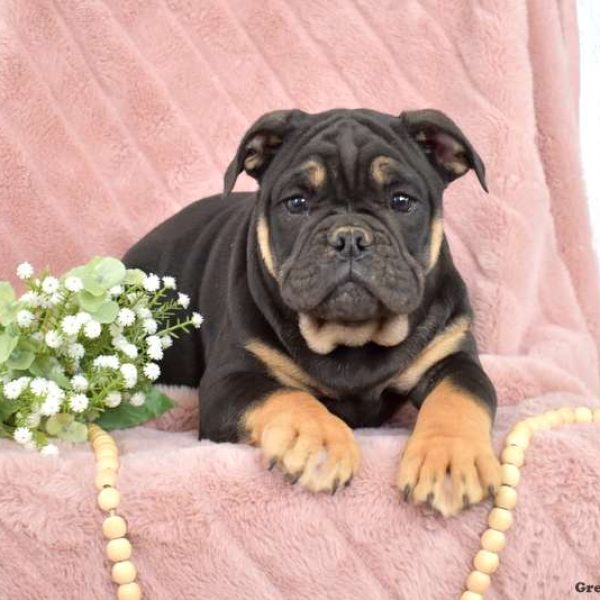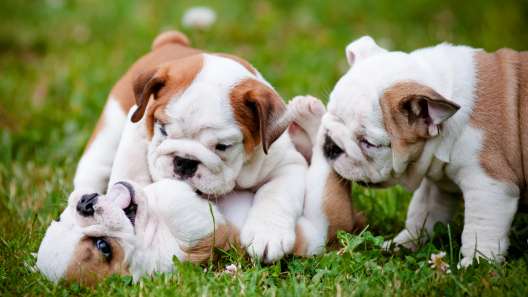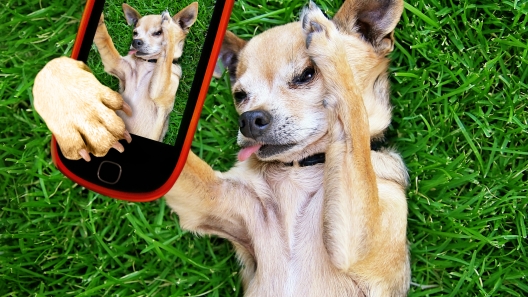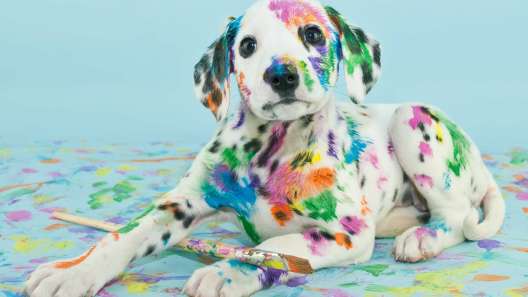-
Activity Level:
moderate
-
Shedding Level:
moderate
-
Grooming Level:
low
-
Trainability:
high
-
Good for Novice Owners:
moderate
-
Adaptability:
high
-
Kid/Pet Friendly:
often
-
Prey Drive:
low
-
Watchdog:
aware
- Average Size: Medium
- Average Lifespan: 9-14 years
- Registered?: aca, other
Olde English Bulldogge Dog Breed Information
Overview
Temperament
Adaptability
Health
Owner Experience
Grooming
Activity Level
Size
Life Span
Did You Know?
The Olde English Bulldogge is a mixed breed that originated in Pennsylvania. David Leavitt of Coatsville is credited with founding the breed, which he started back in the early 1970s. By crossing English Bulldogs with Bullmastiffs, American Pit Bull Terriers, and American Bulldogs, Leavitt’s goal was to create a Bulldog more similar in stature to the bull-baiting dogs of the 18th century, but without the aggression that was common in the breed back then.
The goal with the Olde English Bulldogge was that they would be taller with longer legs and longer snouts than the modern English Bulldog. Achieving this would also help to reduce many of the health issues associated with the modern English Bulldog as a result of their flat face, short snout, and short stature.
Olde English Bulldogges tend to meet these standards. They also tend to have a friendly temperament, an athletic build, and are loyal to their families. Although the American Kennel Club does not currently recognize the Olde English Bulldogge, the United Kennel Club recognized them in 2014. They can also be registered with the Olde English Bulldogge Kennel Club.
Olde English Bulldogges may look tough, but they tend to have a docile and gentle nature with a sweet disposition. Much like the English Bulldog, they love their families and are total sweethearts. They get along well children, other dogs, other pets, and also strangers.
They have a protective instinct, but tend to be friendly and outgoing with everyone unless they sense a real threat. Because of this, proper socialization and training are very important. Poorly socialized dogs of any breed tend to react fearfully to new situations, people, and things, which means they view things as threats that aren’t.
This dog breed is highly adaptable. They thrive in larger homes with room to run. But, they can also adapt well to apartment living as long as they are given enough attention, mental stimulation, and exercise.
As with any dog breed, the Olde English Bulldogge is sensitive to heat and is still more sensitive to heat than some dog breeds. However, due to their longer snout and larger frame, they do not have the breathing problems common to brachycephalic breeds. As such, they do well in most climates. They do not like to spend a lot of time alone because they bond closely with their families and love to be around them.
Although the Olde English Bulldogge was bred to reduce a lot of the health issues common to the modern English Bulldog, there are still some potential health concerns to be aware of, as with any dog breed. With the Olde English Bulldogge, potential health concerns include hip dysplasia, eye problems, and elbow dysplasia.
Reputable breeders will screen their stock to avoid passing on issues to puppies. So, don’t be afraid to ask them about the genetic history of the parents and to see any relevant health clearances or test results. They are also at a higher risk for bloat, which can quickly become dangerous. Knowing the signs of bloat in dogs as well as tips for how to prevent it can be a big help.
Olde English Bulldogges are intelligent and eager to please, which makes them a highly trainable dog breed. They can have a stubborn streak that is common to Bulldogs, which can sometimes be challenging for first-time dog owners to handle.
Puppy training and obedience classes can be a big help for dog owners of any experience level. Plus, they often offer opportunities to socialize a puppy.
This dog breed has a short coat that will shed moderately year-round, but is relatively low-maintenance. Brushing a few times a week and the occasional bath will keep this dog’s coat healthy and looking great.
In addition to coat care, you will also need to care for your Olde English Bulldogge’s nails, ears, wrinkles, and teeth. Cutting your dog’s nails monthly is usually sufficient to keep them from growing too long. You may need to trim them more often if they aren’t wearing down as much naturally or if your dog’s nails just grow quickly.
Checking ears weekly and carefully cleaning your dog’s ears as needed can help prevent ear infections. When looking at your dog’s ears, you’re checking to make sure ears are dry, clean, free of debris, and that there isn’t a lot of excess wax. You also want to clean your Olde English Bulldogge’s wrinkles regularly to keep them from getting irritated or trapping dirt, food, moisture, debris, or drool.
Good dental care for dogs is also essential. Due to a lack of good dental care in dogs, gum disease is one of the most common canine health problems. But, it doesn’t have to be! Brushing your dog’s teeth or using an enzyme toothpaste every day can help prevent painful dental diseases like gum disease, tooth decay, and tooth loss later in life.
Olde English Bulldogge’s tend to like to chew so vet-approved dental hygiene chews can be a great supplement to your dental care efforts. You can also work with your vet to identify good dental hygiene treats and to create a “dental care diet” for your pooch.
An Olde English Bulldogge has an athletic build, an energetic personality, and moderate exercise requirements. Daily walks plus some playtime and extra activity are plenty for this dog. When their bones are still developing, you want to keep strenuous exercise and jumping to a minimum as this can damage their developing joints.
Larger dog breeds often don’t stop growing until they are 1-2 years old. Your vet can help you track this better during puppy visits and give you a better idea of when your Olde English Bulldogge is ready to take on more strenuous exercise.
A fully-grown Olde English Bulldogge usually stands 16-20 inches tall at the shoulder and weighs 50-80 pounds.
An Olde English Bulldogge generally lives 9-14 years.
Leavitt Bulldogges are Olde English Bulldogges too, but they are specifically the Olde English Bulldogges from David Leavitt’s line of dogs.









